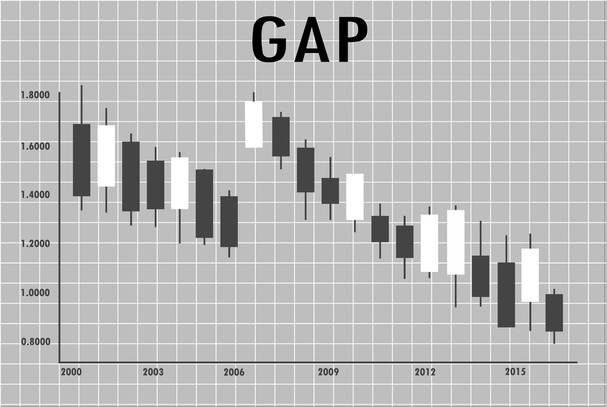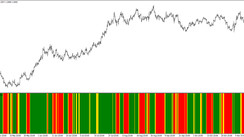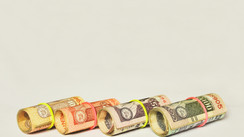“The price always fills the gap.” This is a common quotation among traders on the financial markets. What this means is that when the day closes at a particular price and opens at another price, whether it is higher or lower than that previous close, once trading begins, the price will most probably move to fill the gap. The gap is the difference between the closing price on one day and the opening price on the following day.
Stock Market and Gaps
Gaps are common in the stock market because trading usually only occurs between set market hours depending on which stock exchange trading is being conducted. For example, the New York Stock Exchange is only open between 9:30am and 4:00pm ET. every weekday.
Even though trading may occur beyond this time, the charts would not have been updated. There is therefore a gap between the hours of 4:01pm and 9:29am on the following day. During this time, the ask and bid prices may change and this change is reflected in the opening price on the following day.
In general, all markets with set market hours are often a subject to gaps in prices between trading and non-trading hours.
Forex and Gaps
Although the Forex market operates 24 hours per day, the markets are technically closed during the weekends on Saturdays and Sundays. However, the forex market is only closed to retail traders. The large banks and hedge funds may still trade during the weekend and this trading creates gaps.
Gaps tend to develop based on fundamental news during the period when the markets are closed to retail traders but may also be based on technical factors such as breakouts. Therefore, although there are usually no gaps in the Forex market during the weekdays, gaps are common during the weekends.
For example, the GBP/USD may close the week at a price of 1.2192 and open on late Sunday evening or the next Monday (depending on your broker) at a price of 1.1996, there would have been a gap down of 196 pips. When trading begins on Sunday or Monday, the price can tend to move upwards in order to fill that gap. You can clearly see such situation in the chart below. And if the gap was an upside gap, the price would tend to move downwards to fill that gap.
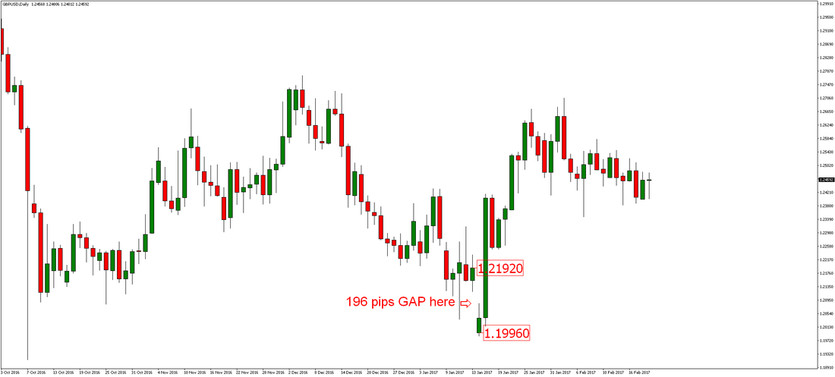
Types of Gaps in the Forex Market:
There are three different types of gaps that may be formed on any market.
Breakaway gap
The first type of gap is called a Breakaway gap . With a breakaway gap, it can indicate that a new trend is about to develop. Whenever the market is bound by ranges and the gap forms outside of this range, that is what is called a breakaway gap.
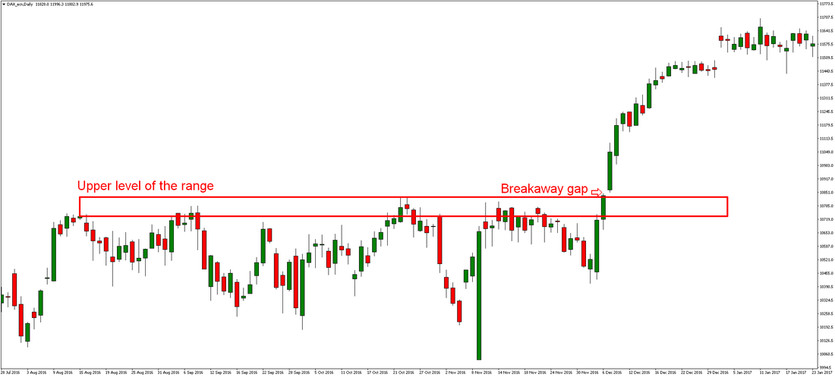
Runaway gap
Another type of trading gap is the Runaway gap in which the gap forms in conformance with the current trend. For example, if the current trend is bullish and the gap that is formed is a gap up, then that gap is a runaway gap. Vice versa applies for bearish runaway gaps.
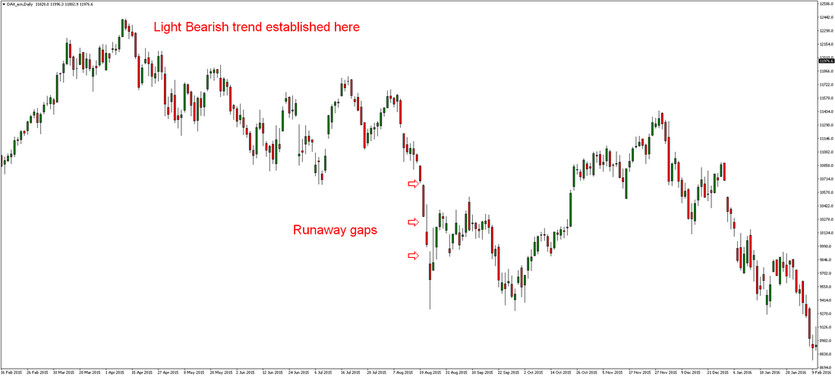
Exhaustion gap
The final type of trading gap is known as an Exhaustion gap . As the name suggests, this type of gap indicates a trend reversal following a long and prominent trend. The best way to trade the exhaustion gap is usually to watch the following candle and upcoming candlestick pattern or price action . In the chart below, you can see that the following candle after the exhaustion gap formed the Doji candlestick pattern. This was a clear reversal pattern.
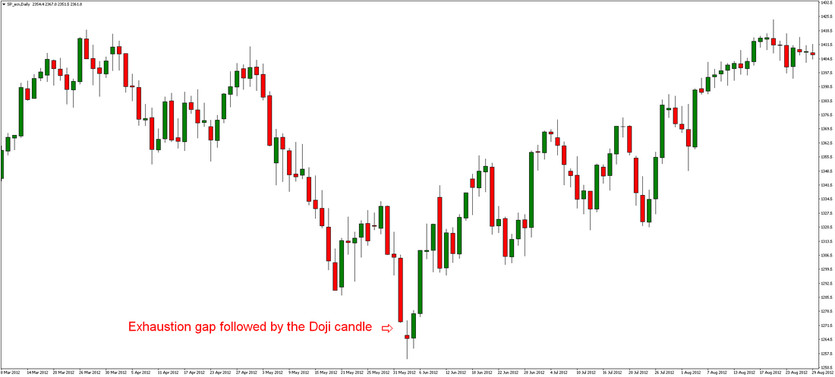
How to Trade the Gaps
Trading the gaps is a matter of choice. While some traders swear by trading gaps, other traders avoid doing so. Some traders have found that, depending on the particular currency pair, the gap tends to be filled in the majority of cases. These traders therefore feel comfortable trading the gap.
On the other hand, other traders are of the view that the gaps don’t always get filled and that they tend to be filled less often than not. These traders avoid trading the gaps.
The truth is that trading the gaps may be profitable if you choose the right currency pairs or stock indices and if those markets tend to fill the gaps more often than not. If you choose to trade the gaps, there are a few things that you should bear in mind.
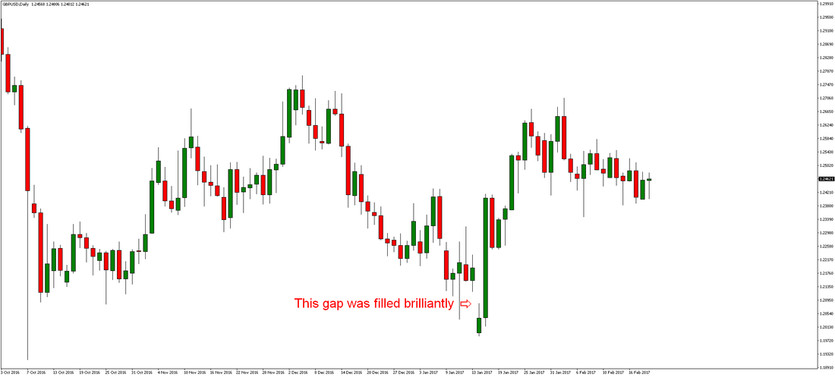
To begin with, it is best to use a currency pair or market that is very volatile. When this is the case, the gaps tend to be wider and the probability of most of them being filled is greater than with less volatile currency pairs or other markets. Once you have identified an appropriate currency pair, you should look for trading gaps on Sunday evening or Monday morning (depending on when your broker starts trading after weekends).
With this type of strategy, some traders believe that it is best to avoid using stop losses and take profits since the bottom and the tops of the gaps would naturally act as stop loss and take profit points. However, other traders believe that stop losses should always be used and should be set at key resistance or support levels to avoid huge losses. The choice depends on the choice of every trader based on his own risk assessment. However, in general, stop-loss orders should be definitely placed in every trade.
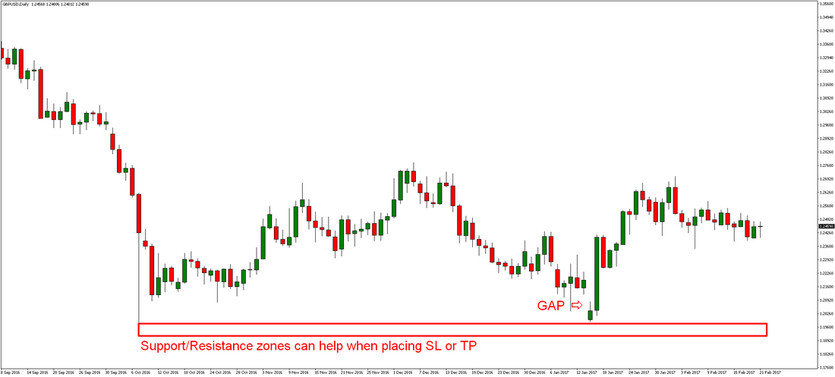
When trading the gaps, you can keep the trade open until near the end of the weekly trading session. Five minutes before the week closes may be a good time to close the trade. Or another way is to close the trade as soon as the gap gets filled. Even both trade exit strategies can be combined and used for partial trade closure.
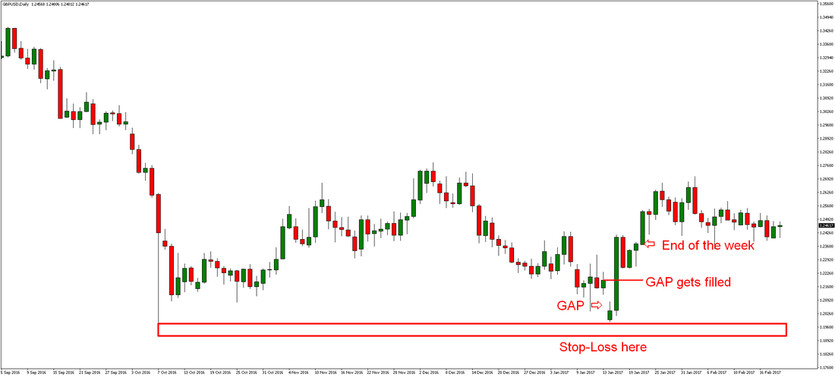
If you decide not to trade the gaps, you may still meet the gaps when trading based on strong candlestick patterns such as strong dark cloud cover, a bullish abandoned baby, or bullish piercing or engulfing patterns.
Conclusion
Trading the gaps in the forex market may prove to be a profitable undertaking if the currency pairs have a relatively high level of volatility. However, there are no guarantees that the gaps will be filled and therefore, trading the gaps should be done with caution. For the more risk-averse trader, it is always best to use stop losses. For those who choose not to trade the gaps in the forex market, the gaps may still be used to identify and confirm strong candlestick patterns.

